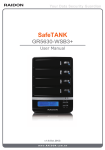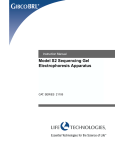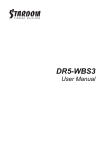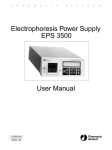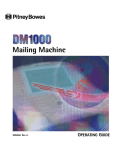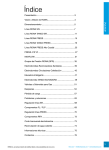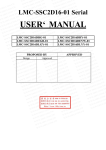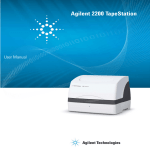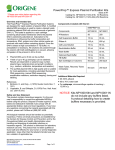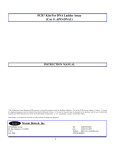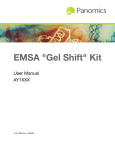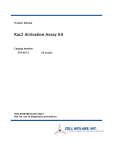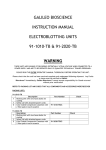Download Model PS9009 TC Prog. High Voltage Power Supply user manual
Transcript
Model PS9009 TC Programmable Electrophoresis Power Supply CAT. NOS. 31067-242 10556-017 Table of Contents 1. Introduction ................................................................................................. 1 1.1 1.2 Notice to Customer ................................................................................... 1 Warnings .................................................................................................. 1 2. Overview ....................................................................................................... 2 2.1 2.2 Description................................................................................................ 2 Set-Up ...................................................................................................... 2 3. Operating Instructions ............................................................................ 4 3.1 3.2 3.3 3.4 3.5 3.6 3.7 3.8 3.9 Programming and Operating a One Time Single Step Program .............. 4 Programming and Operating a Sequential Program .................................... 5 Programming and Operating the Low Current Program............................... 5 Temperature Control Program.................................................................... 5 Setting Safe Operating Limits ................................................................... 6 Relationships Between Volts, Milliamps, Watts and Chamber Resistance ......................................................................... 7 Running Multiple Chambers ..................................................................... 7 Using Automatic Crossover ...................................................................... 8 Integration................................................................................................. 8 4. Troubleshooting Guide ........................................................................... 9 4.1 4.2 4.3 Display Messages...................................................................................... 9 4.1.1 Start Up Message ......................................................................... 9 4.1.2 End of Run Display ........................................................................ 9 Fault Detection Messages ........................................................................ 9 4.2.1 No Load Detection Message ........................................................ 9 4.2.2 Ground Leakage Message ......................................................... 10 4.2.3 Power Fault Message ................................................................. 10 4.2.4 Memory Lost Message ............................................................... 10 4.2.5 Power Restart Message ............................................................. 10 General Troubleshooting ........................................................................ 11 5. Related Products ..................................................................................... 12 6. Additional Information .......................................................................... 13 6.1 6.2 6.3 6.4 Care and Handling ................................................................................... 13 Specifications........................................................................................... 13 Warranty ................................................................................................. 14 Declaration of Conformity and CE Mark ................................................. 14 Figure: 1. Model PS9009 TC Programmable Electrophoresis Power Supply..................................................................................................... 3 GEL-MIX®, HORIZON®, TECH-LINE , and the Life Technologies logo are marks of Life Technologies, Inc. SM i Introduction 1.1 ! 1 Notice to Customer This product is authorized for laboratory research use only. The product has not been qualified or found safe and effective for any human or animal diagnostic or therapeutic application. Uses for other than the labeled intended use may be a violation of applicable law. 1.2 Warnings 1. DANGER! HIGH VOLTAGE! This power supply has been designed for use as a source of DC power for electrophoresis. It is capable of generating lethal currents. This unit should always be operated with extreme caution. Careless handling could result in electrical shock. 2. Never operate damaged equipment. Do not use the unit without the cover in place or with any possible short circuit. If the power supply emits smoke or blows the main fuses, turn off the power supply and disconnect the AC line and power cord. 3. Do not operate with connecting cables that have exposed live wires. 4. Always turn off the power supply before connecting or removing the power cords or moving an electrophoresis apparatus. 5. Handle one power cord at a time, with one hand only, when connecting or removing DC power cords at the power output terminals. 6. Do not immerse this unit in water. 7. Do not operate the unit in a damp, humid atmosphere or in a fashion where condensed moisture may short out electrical components. 8. Do not connect the output to earth ground. 9. The AC power cord has a three-pronged plug which must be connected to a grounded line voltage receptacle. Do not use a two-wire receptacle with an adapter. This could create a serious electrical hazard for persons using the unit. 10. Use the correct voltage AC power outlet for the power supply. Be sure to always plug a 110 VAC power supply into a 110-V line, and use a 240-V line with a 240 VAC unit. 1 2 Overview 2.1 Description The Model PS9009 TC Programmable Electrophoresis Power Supply is intended to be used with electrophoretic devices that operate below 3000 V and up to 300 W, and/or 300 mA DC. The unit includes two sets of output sockets which operate in parallel to provide output in constant voltage, constant milliamps, or constant power (see figure 1). This power supply has the ability to restart itself in the event of a power failure. 2.2 Set-Up Unpacking the Unit. Unpack and inspect the power supply unit carefully for any damage. Do not use the unit if it is damaged. If damage is found, save the packing material and report the problem to Life Technologies’ Customer Service. Location. Make sure the unit is set up in a location where it is protected from physical damage, moisture, corrosive agents, and extreme temperatures. Make sure the fan at the rear is not obstructed; leave about 20-cm of space behind the unit. The unit should be readily accessible for safe operation. Connection with the AC Mains. Connect the unit to the AC mains carrying the appropriate specified voltage (V) in accordance with the rating label affixed to the back of the unit. Ensure that both the main receptacle and the power supply plug have the proper three-wire (grounded or earthed) connections. 2 Overview 2 5 2 3 4 7 8 6 3000V 250mA 250W P23 99999VHR 99999min S# PROBE DANGER HIGH VOLTAGE LIFE TECHN O LO G IES 21 22 23 No. 1 2 3 4 5 6 7 8 9 10 11 12 13 14 15 16 17 18 19 20 21 22 23 V mA 1 2 11 oC W VHR 3 13 7 6 5 4 15 14 12 18 DESCRIPTION AC Mains Power ON/OFF Switch Voltage Output Display Current Output Display Power Output Display Volt/Hour Display Timer Display Program Number STEP Number Resume Switch Start/Stop Switch Start LED Stop LED Volt Selector mA Selector Watt or °C Selector VHR Selector MIN Selector Program Selector Previous Step Selector Next Step Selector High Voltage Output Jacks Numeric Keypad Temperature Probe Output 0 9 9 19 17 16 8 20 1 10 FUNCTION Turns on the main power Displays actual or set Volts Displays actual or set mA Displays actual or set Watts Displays actual or set VHR Displays actual or set MIN Displays actual or preset program Displays actual or preset step Resumes timer and VHR values Starts or stops High Voltage Output Green LED indicates High Voltage on Red LED indicates High Voltage off Permits entry of volt set point Permits entry of current set point Permits entry of Watt or temperature set point Permits the entry of Volt/Hour end point Permits the entry of Time end point Permits the entry of program number Previous selection of steps Next selection of steps RED=POSITIVE; BLACK=NEGATIVE Permits entry of all parameters Connection of the external surface probe Figure 1. Model PS9009 TC Programmable Electrophoresis Power Supply. 3 Operating Instructions 3 Note: The Low Current Program (P28) can not be used for DNA sequencing. The touch key pads on the front of the Model PS9009 TC Programable Electrophoresis Power Supply (figure 1) are used to program and run the unit. The power supply can be operated in any of three different modes: Constant Voltage, Constant Current, or Constant Power with automatic crossover. The power supply can also be run with temperature regulation. The power supply stores up to 24 different programs which are arranged into three different types. Programs coded P01 to P08 and P11 to P18 are one time single step programs. Programs coded P21 to P27 are multiple step programs and can have up to 10 steps. The program coded P28 is designed for low current operation. This is a multiple step program for operation < 1 mA. 3.1 Programming and Operating a Single Step Program There are 16 available single step programs, coded P01 to P08 and P11 to P18, that can be set. These programs include automatic shutoff and are identified by S# on the display panel. This symbol indicates that for each program there is only a single programmed step. Each program is maintained in the memory of the power supply. Electrophoresing a vertical polyacrylamide sequencing gel at 60 W (constant power) for 3 h. 1. 2. Switch the AC Mains Power ON/OFF Switch to the ON position. An alarm sounds to signify the start up of power. Press the Start/Stop keypad to silence the alarm. The last program used is displayed. 0000 V 000 mA 000 W P01 00000 VHR 0000 min S# 3. 4. 5. Note: A value for both the VHR and minutes must be entered for the power supply to operate. Press the Program keypad and enter the program number using the numerical keypad. To enter the setting parameter, press the keypad of the parameter to be changed, and then using the numerical keypad, enter the desired value. Values which are out of limits are not accepted. Enter 3000 V, 300 mA, 60 W (entered 060), 99999 VHR and 180 min (entered 0180). The V, mA and VHR functions are set at maximum so they are not limiting factors. After each value has been entered, the display remains for 5 s and then changes to display all zeros. Press any keypad to return to the program that is being entered. 3000 V 300 mA 060 W P01 99999 VHR 0180 min S# 6. Press the Start/Stop keypad to start electrophoresis. The Model PS9009 TC Power Supply has automatic crossover with the limiting parameter being indicated by the blinking display. 4 Operating Instructions Electrophoresis stops at the end of the programmed time or can be manually stopped by pressing the Start/Stop keypad. Press the Start/Stop keypad to resume electrophoresis at the point where it was stopped. 3.2 Programming and Operating a Multiple Step Program There are 7 available multiple step programs, coded P21 to P27, that can be set. Each program can have up to 10 individual steps which are identified by S0 to S9 on the display panel. 3 Running a program to electrophorese an SDS-PAGE gel first at a constant current of 15 mA for 30 min and then at a constant current of 30 mA for 90 min. 1. 2. 3. 4. Switch the AC Mains Power ON/OFF Switch to the ON position. An alarm sounds to signify the start up of power. Press the Start/Stop keypad to silence the alarm. The last program used is displayed. Press the Program keypad and enter the program number using the numerical keypad. Using the next and previous keypads select the step to be entered (S0 to S9). 0000 V 000 mA 000 W P21 00000 VHR 0000 min S0 Note: A value for both the VHR and minutes must b entered for the power supply to operate. 5. 6. To enter the setting parameters, press the keypad of the parameter to be changed, and then using the numerical keypad, enter the desired value. Values which are out of limits are not accepted. Enter 3000 V, 15 mA, 300 W, 99999 VHR and 15 min on step S0. The V, W, and VHR functions are set at maximum so they are not limiting factors. 3000 V 015 mA 300 W P21 99999 VHR 0015 min S0 7. 8. Press the Next keypad to switch to the next step to be entered. Enter 3000 V, 30 mA, 300 W, 99999 VHR, and 90 min on step S1. The V, W, and VHR functions are set at maximum so they are not limiting factors. 3000 V 030 mA 300 W P21 99999 VHR 0090 min S1 9. Press the Start/Stop keypad to start electrophoresis. 10. At the end of the 15 min first step in the program, the power supply switches automatically to the next step. At the end of the last programmed step, the power supply automatically shuts off the voltage and current to the electrophoretic chamber. 3.3 Programming and Operating the Low Current Program Program coded P28 is a dedicated low current (<1 mA) program that is operated and programmed in the same fashion as the other multiple step programs. It is not used for sequencing or other applications requiring the use of high current. 3.4 Temperature Control Program The Model PS9009 TC Power Supply is designed for automatic temperature regulation as well as that for Voltage, Current and Power. The optional temperature probe maintains constant temperature during electrophoresis by reducing or stopping the voltage and current output when the set temperature is surpassed. 5 Operating Instructions Once the temperature drops below the set point, both voltage and current output is resumed at the preset levels. The use of the temperature regulation mode prevents the activation of the power (Watt) regulation mode. 1. 2. 3. Note: The temperature control option can be used with any of the programs stored in the memory of the Model PS9009 TC Power Supply. 4. Switch the AC Mains Power ON/OFF switch to the ON position. An alarm sounds to signify the start up of power. Press the Start/Stop keypad to silence the alarm. The last program used is displayed. Press the Program keypad and enter the program number using the numerical keypad. Program the desired parameters for electrophoresis. Instead of programming Watts, press the W/°C keypad a second time. The display shows _ _ _ °C instead of _ _ _ W. Enter the desired upper temperature limit for the gel. The range goes from 00° to 99° C. For example 40°C would be entered as 040. 0000 V 000 mA 040°C 00000 MinR 0000 MinT P01 S# The display MinR is a timer that is dedicated for increments of minutes while the Model PS9009 TC does not supply current or voltage. This timer works only when the voltage and current are turned off in the temperature regulation mode. The main timer (MinT) remains operational at all times during the operation of the power supply and provides the automatic termination of the voltage and current output. After the electrophoresis has automatically stopped, it may be necessary to continue electrophoresis for the time that the voltage was discontinued. 3.5 Setting Safe Operating Limits Electrophoretic chambers are generally designed for a relatively specific purpose. For example, submarine chambers use agarose gels to separate DNA or RNA fragments, while a DNA sequencing chamber is almost always used to separate DNA in a denaturing polyacrylamide gel. In each case, the voltage, milliamp, and wattage requirements are well defined within a reasonable range of values. In cases such as these, the user can safely assume that the manufacturer has designed the chamber to withstand the voltage and heat energy necessary to perform the electrophoretic separation when standard protocols are followed. Some types of electrophoretic chambers are specifically designed to be multipurpose devices. For example, a vertical slab gel chamber could be used for anything from DNA sequencing to isoelectric focusing, depending on the gel type and buffer system used. Choosing safe operating limits for a chamber of this type requires a higher degree of caution. Chamber manufacturers normally rate their product for maximum voltage and/or maximum wattage. Whenever possible, contact the manufacturer and request this information. Whether you use special purpose or multipurpose chambers, the maximum operating temperature the chambers will withstand is a critical aspect of safe operation. Most electrophoretic chambers (with a few notable exceptions) are made of acrylic and plastic and should operate below a temperature of 35°C. If there is a lack of information about the capabilities of the chamber being used, regular monitoring of the operating temperature is recommended. This should be accomplished without coming into physical contact with the chamber when voltage is applied. The following procedure illustrates how normal operating conditions can be determined and how this information can be used to choose safe operating limits for agarose gel electrophoresis in a submarine chamber at a constant voltage of 125 V. 6 Operating Instructions 1. 2. 3. Note: When operating in constant current or constant power, and setting a limit for voltage, select a value which is greater than the actual value by 10% or 25 V, whichever is greater. Adjust the operating limits to 125 V, 300 mA, 300 W. Start electrophoresis and note the mA and W values when the voltage has reached 125 V and begins to blink. Adjust the mA and W settings so that they exceed the actual values by 10% or 10 mA and 5 W, whichever is greater. Thus, the SET and ACTUAL values may look like this: SET = 0125 V 055 mA 011 W ACTUAL = 0125 V 045 mA 006 W 3 In the procedure listed above, we first determined the actual output wattage and milliamps for operation at 125 V and then chose operating limits that were at a slightly higher level than those indicated for mA and W. This approach ensures that the maximum output from the power supply will never exceed the normal operating conditions by more than 10%. Some users prefer to set up the chamber, switch the power supply’s output ON, and adjust the operating limits before the samples are actually loaded. Once the user has confirmed that the chamber and the power supply are functioning properly and determined the safe operating limits, the power supply’s output is switched OFF, and the samples are loaded. Since the power supply will remember the settings of the operating limits, the output can be switched back ON without further adjustments. 3.6 Relationships Between Volts, Milliamps, Watts and Chamber Resistance Three fundamental concepts form the basis for understanding the relationship between volts, milliamps and chamber resistance. When combined with the power formula they also define watts. 1. A movement of free electrons from atom to atom forms an electric current which is measured in milliamps (mA) or amps (A). 2. Electrostatic lines of force between two different charges produce a pressure that can move electrons (measured in volts). 3. All substances oppose the movement of electrons to some extent and are said to have resistance (measured in ohms). These three factors are always present in any operating electric circuit. It is possible to incorporate them into one inclusive statement: Ohm’s Law The value of the current that will flow in any circuit will be directly proportional to the value of the voltage applied and inversely proportional to the value of the resistance. or amps = volts / resistance combined with The power formula: volts ! amps = watts (where 1 amp = 1,000 mA) Together, these two formulas define the relationship between volts, milliamps, watts and chamber resistance. 3.7 Running Multiple Chambers This power supply is equipped with two sets of 4-mm output connectors which are connected in parallel because: 1. 2. The voltage is applied equally to all branch paths in a parallel circuit. The current flow in the branch paths of a parallel circuit is determined by the resistance of the individual paths. 7 Operating Instructions 3. The sum of the currents entering the branch paths of a parallel circuit is equal to the sum of the currents leaving the branch paths of a parallel circuit. A practical example of this is described as follows: The power supply is connected to two identical horizontal submarine electrophoresis chambers (cells A and B). The power supply output is adjusted to 100 V, at constant voltage, and the current display indicates 60 mA. By applying the three rules for parallel circuits, we can determine the following information: 1. 2. The voltage applied to both Cell “A” and Cell “B” is 100 volts (Rule 1). The sum of the currents flowing through Cell “A” and Cell “B” is equal to 60 mA (Rule 3). Switch OFF the power supply and momentarily disconnect Cell “B”. Switch the power supply back ON and note how the output current reading drops to 35 mA. From this, the following information can be derived. 1. 2. 3.8 The current flow through Cell “B” is equal to 60 mA - 35 mA [a net value of 25 mA (Rule 3)]. The reason Cell “A” and Cell “B” have different current readings is due to the difference in resistance between Cells “A” and “B” (Rule 2). Using Automatic Crossover Certain electrophoretic techniques require the careful adjustment of operating limits and the utilization of the automatic crossover feature of this power supply. Automatic crossover involves a transition from one mode of operation ( e.g., constant current) to another mode of operation such as constant voltage. Semi-dry electroblotting exemplifies the utility of this feature. Semi-dry transfer chambers contain two closely spaced parallel electrode plates. A “sandwich” consisting of buffer-saturated filter paper sheets on the outside and a gel and a charged transfer membrane on the inside is assembled and placed between the electrode plates. Typical protocols suggest that the transfer should be carried out at a constant current. As the transfer process progresses, the buffer in the two filter paper layers heats up and begins to break down. This breakdown leads to an increase in the overall resistance between the two plates. In the constant current mode, the increase in resistance leads to a voltage increase. Left unchecked, the increasing voltage can eventually lead to arcing which would damage the electrode plates, the gel and the transfer membrane. To eliminate the arcing problem, the voltage should be set at an operating limit which is below the threshold needed for the arc. As the voltage increases, it will eventually reach the predetermined operating limit. At this point, the power supply will automatically cross over from the constant current mode to the constant voltage mode of operation. As the transfer is completed, the current will gradually diminish. 3.9 Integration The conductivity of the buffer in the electrophoresis chamber can change during the course of a run and result in changes in the voltage, current or wattage being applied. Integration of the output over a given time period takes such changes into account by monitoring volt-hours or milliamp-hours or watt-hours. The vh integration method is used most frequently since the rate of migration of molecules through gels is proportional to the voltage that is being applied. The way this feature can be used is described as follows. If we run an experiment at constant voltage, at an output of 110 V for 3 h, we will accrue 330 vh. We know this is true since the voltage was held constant for 3 h. During the course of this same experiment, the output current varied from a maximum of 50 mA to a minimum of 25 mA. Now suppose we wish to repeat the experiment at constant current, but we want the same effect as 3 h at a constant voltage of 110 V. At constant current, we know the output voltage must vary since the current varied when we performed the experiment at constant voltage. If we select a vh limit of 330 vh, the power supply automatically stops when the total for the vh equals 330, regardless of the fluctuations in the voltage. 8 Troubleshooting Guide 4.1 4 Display Messages 4.1.1 Start Up Message GIBCO BRL press STOP to resume This is the start up message when the power supply is first turned on. An alarm will also sound. Press the start/stop keypad to display the last used program. 4.1.2 End of Electrophoresis Display regulation END press STOP to resume Power output has stopped at the end of the last programmed step. Change the step or program to continue. 4.2 Fault Detection Messages WARNING! This notice and the messages below alert you to potentially dangerous situations. CAUTION! This notice means serious damage may occur to your power supply or chamber. 4.2.1 No Load Detection Message LOAD fault press STOP to resume The LOAD Fault Detection message and the continuous tone alarm indicate that the circuit between the power supply and the electrophoresis apparatus is not closed. Check that all of the leads are connected properly and press the start/stop keypad to resume. An open connection could be caused by any of the following conditions: 1. 2. 3. 4. a broken electrode within the electrophoretic chamber, a broken wire within the connecting cord, insufficient buffer levels in the electrophoretic chamber, or electrochemical energy stored within the electrophoretic chamber. 9 Troubleshooting Guide 4.2.2 Ground Leakage Message LEAKAGE fault press STOP to resume The LEAKAGE Fault Detection message indicates that some of the current output is flowing to earth ground. This situation can be hazardous. Switch the AC Mains Power ON/OFF Switch to the OFF position. Check the leads and connections and make sure that no buffer is leaking from the electrophoresis chamber onto the bench before proceeding. Contact the TECH-LINESM if the problem persists. 4.2.3 Power Fault Message POWER fault press STOP to resume The POWER Fault Detection message indicates that there is a POWER CIRCUIT FAILURE. This may be caused by internal excess current in the power supply. Reset the power supply by switching off the AC Mains Power ON/OFF Switch to the OFF position and then ON again. Contact the TECH-LINE if the problem persists. 4.2.4 Memory Lost Message MEMORY lost press STOP to resume The Memory Lost message indicates that the permanent memory has been lost due to a circuit failure or a problem in the software. Reset the power supply by switching off the AC Mains Power ON/OFF Switch to the OFF position and then ON again. Contact the TECH-LINE if the problem persists. 4.2.5 Power Restart Message POWER IS COMING ON press STOP to resume The Power Restart message indicates that there has been a power failure of the AC Mains. The automatic restart of the unit will occur in 10 s at which time the audible alarm will stop. The power supply will restart with the preset values. 10 Troubleshooting Guide 4.3 4 General Troubleshooting Many procedural and operational problems can be solved by carefully following the instructions in this manual. Some suggestions for equipment and procedural troubleshooting are given below. Should these suggestions not resolve the problem, or if you have questions regarding procedures, call the TECH-LINE (numbers listed on the back cover of this manual). If you need to return the unit for repair, contact the Customer Service Department or your local distributor for shipping instructions. Include a full description of the problem. Problem Comments Display fails to illuminate when the power supply is turned on Make sure that the AC Mains power cord is plugged into a functioning outlet. Check the AC Mains fuse on the back of the power supply. Replace if blown. Desired MODE not flashing Increase the output setting for the MODE that is limiting until the desired MODE is flashing. Two different MODES are blinking alternatively Settings for both parameters are too close to actual output. Under constant power MODE (W), output displays are not stable Increase the set value for the MODE that is not limiting. Load and gel resistance are changing. Disregard slight fluctuations. Display voltage and current will stabilize as gel equilibrates. Increase or decrease W set value by 1 or 2 Watts to stabilize. When using the temperature control MODE, the separation is not complete When the temperature limit is reached, the power supply shuts off both voltage and current output. Check the MinR display and then electrophorese the gel for the total time displayed on this timer. Make sure that the correct voltage limiting value was set. Temperature Display shows symbols instead of temperature Make sure that the temperature probe is properly connected to power supply. Voltage is shut off during electrophoresis Increase the temperature limit value. Decrease the electrophoresis parameters. Display actual temperature is not stable Make sure that the probe in in complete contact with the glass plates. 11 5 Related Products Product 12 Cat. No. Model PS 3002 Electrophoresis Power Supply Model 4001 Electrophoresis Power Supply Model 4001P Programmable Electrophoresis Power Supply Model S2 Sequencing Gel Electrophoresis System Model SA-32 Sequencing Gel Electrophoresis System Model SA-60 Sequencing Gel Electrophoresis System Model SA-88 Sequencing Gel Electrophoresis System Model V15•17 Vertical Gel Electrophoresis System GEL-MIX® 6 6% Sequencing Gel System GEL-MIX 8 8% Sequencing Gel System dsDNA Cycle Sequencing System (100 reactions) HORIZON® 11•14 Horizontal Gel Electrophoresis Apparatus HORIZON 20•25 Horizontal Gel Electrophoresis Apparatus HORIZON 58 Horizontal Gel Electrophoresis Apparatus Temperature Probe 31067-234 31067-069 31067-119 21105-010 31096-019 31096-035 31096-050 21080-015 15543-010 15545-015 18196-014 11068-012 21069-018 41060-013 31067-291 Replacement Parts: Fuse, T 4.0 A, 250 V Fuse, T 2.0 A, 250 V 31067-275 31067-283 Additional Information 5.1 6 Care and Handling This power supply uses all solid-state components and should require no maintenance or recalibration under normal use. If the unit must be returned for repair, contact Life Technologies’ Customer Service Department for shipping instructions. Please include a full description of the problem. As with any laboratory instrument, adequate care ensures consistent and reliable performance. After each use, wash all components gently with water and nonabrasive soap or detergent, and rinse well in deionized water. Wipe dry with a soft cloth or paper towel, or allow to air dry. Do not allow water to enter the case. To remove grease and oils, use a light application of hexane, kerosene, or aliphatic naphtha. Never use abrasive cleaners, window sprays, or rough cloths to clean the components, as these can cause surface damage. Additional cautions: • Do not autoclave or dry-heat sterilize the apparatus or components. • Do not expose the apparatus or components to phenol, acetone, benzene, halogenated hydrocarbon solvents, or undiluted laboratory alcohols. • Avoid prolonged exposure of the apparatus or components to UV light. 5.2 Specifications Net Weight: . . . . . . . . . . . . . . . . . . . . . . . . . . . . . . . . . . . . . . . . . . . . . . . . . . . . 3.5 kg (7.7 lb.) Shipping Weight: . . . . . . . . . . . . . . . . . . . . . . . . . . . . . . . . . . . . . . . . . . . . . . .6.0 kg (13.2 lb.) Dimensions (D ! W ! H) . . . . . . . . . . . . . . . . . . . . . . . 33 ! 27 ! 11 cm (12.9 ! 10.6 ! 4.3 in.) Installation Category . . . . . . . . . . . . . . . . . . . . . . . . . . . . . . . . . . . . . . . . . . . . . . . . . . .Type 2 Power Requirement: . . . . . . . . . . . . . . . . . . . . . . . . . . . . . . . 110/220 VAC, 50/60 Hz, 750 W Mains fuse rating: 110 ± 10 vrms operation . . . . . . . . . . . . . . . . . . . . . . . . . . . . . . . . . . . . . . . . .T 4.0 A/250 V 220 ± 20 vrms operation . . . . . . . . . . . . . . . . . . . . . . . . . . . . . . . . . . . . . . . . .T 2.0 A/250 V Maximum Voltage: . . . . . . . . . . . . . . . . . . . . . . . . . . . . . . . . . . . . . . . . . . . . . . . . . . . . 3,000 V Maximum Power: . . . . . . . . . . . . . . . . . . . . . . . . . . . . . . . . . . . . . . . . . . . . . . . . . . . . . . 300 W Maximum Current: . . . . . . . . . . . . . . . . . . . . . . . . . . . . . . . . . . . . . . . . . . . . . . . . . . . . 300 mA Regulation: . . . . . . . . . . . . . . . . . . . . . . . . . . . . . . . . . . . . . . . . . . . . . . . . . . . . . . . . . . . . <1% Accuracy: . . . . . . . . . . . . . . . . . . . . . . . . . . . . . . . . . . . . . . . ± 1.5% full scale for each display Number of Output Terminals: . . . . . . . . . . . . . Two recessed sets of 4-mm output connectors Safety Interlock: . . . . . . . . . . . . . . . . Load sensing shut-down-on-disconnect. Key activation necessary to begin voltage generation. In the event of shutdown due to power interruption, automatic restart is provided. Timer: . . . . . . . . . . . . . . . . . . . . . . . . . . . . . . . . . . . . . . . . . . . . . . . . . . . . . . . . 0 to 99999 min Ground Leakage: . . . . . . . . Leakage of 500 µA will interrupt the generation of high voltage. Integration: . . . . . . . . . . . . . . . . . . . . . . . . . . . . . . . . . . . . . . . . . . . . . . . . . . . . . . . .99999 V-h Programmability: . . . . . . . . . . . . . . . . . . . . . . .8 programs each with 10 steps, 16 single step programs, and 1 low current program with 10 steps 13 Additional Information 5.3 Warranty Life Technologies, Inc. warrants apparatus of its manufacture against defects in materials and workmanship, under normal service, for one year from the date of receipt by the purchaser. This warranty excludes damages resulting from shipping, misuse, carelessness, or neglect. Life Technologies’ liability under the warranty is limited to the repair of such defects or the replacement of the product, at its option, and is subject to receipt of reasonable proof by the customer that the defect is embraced within the terms of the warranty. All claims made under this warranty must be presented to Life Technologies within one year following the date of delivery of the product to the customer. This warranty is in lieu of any other warranties or guarantees, expressed or implied, arising by law or otherwise. Life Technologies makes no other warranty, expressed or implied, including warranties of merchantability or fitness for a particular purpose. Under no circumstances shall Life Technologies be liable for damages either consequential, compensatory, incidental or special, sounding in negligence, strict liability, breach of warranty or any other theory, arising out of the use of the product listed herein. Life Technologies reserves the right to make improvements in design, construction, and appearance without notice. 5.4 Declaration of Conformity and CE Mark Note: The information outlined in this section applies only to customers located in the European Union (EU). The EU is currently comprised of 15 member countries. This laboratory apparatus is identified with the CE mark. This mark indicates that the product complies to the following EU Directives and Standards: Application of Council Directive(s): 73/23/EEC Low Voltage Directive 89/336/EEC Electromagnetic Compatibility Standards: EN 61010-1:1993 EN 50081-1:1992 EN 50082-1:1992 Product Safety Emissions Immunity EU Representative: Life Technologies Ltd. EU Address: 3 Fountain Dr. Inchinnan Business Park Paisley, PA49RF Scotland A copy of the Declaration of Conformity certificate is available upon request. 14 Part No. Lot No. 50892 KJNP01-0898


















